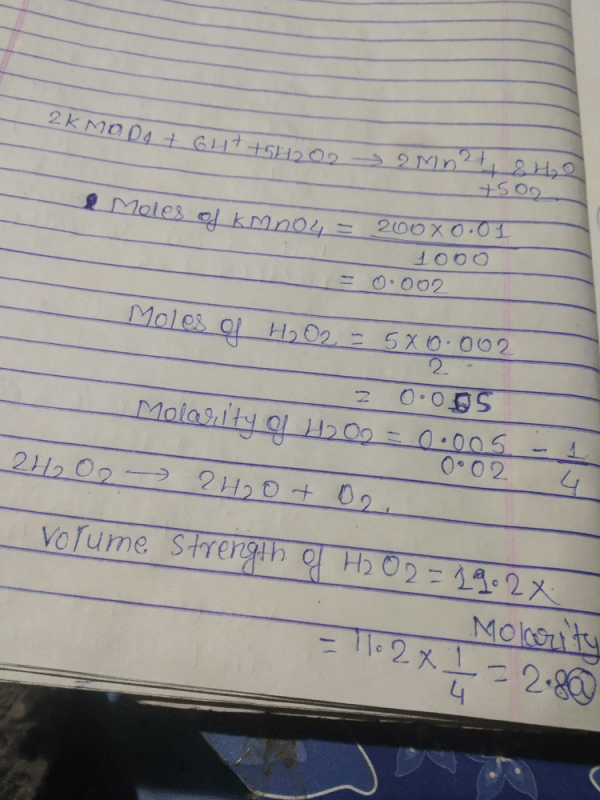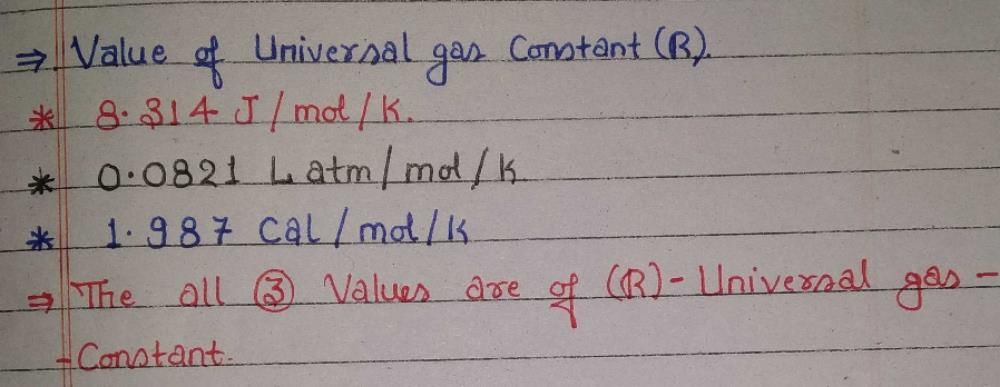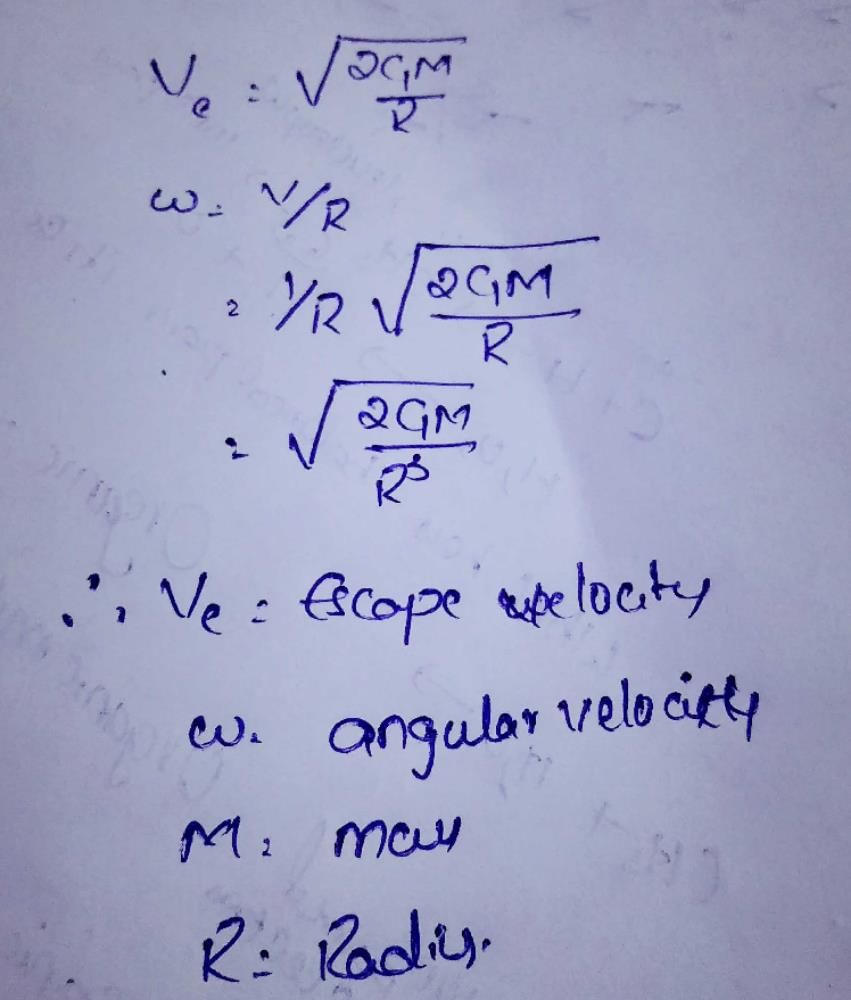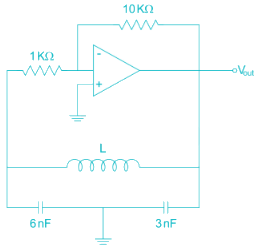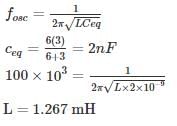All Exams >
Electrical Engineering (EE) >
6 Months Preparation for GATE Electrical >
All Questions
All questions of Practice Tests for Electrical Engineering (EE) Exam
Which gas was probably least abundant in the early atmosphere ?- a)H2O
- b)O2
- c)NH3
- d)CO2
Correct answer is option 'B'. Can you explain this answer?
Which gas was probably least abundant in the early atmosphere ?
a)
H2O
b)
O2
c)
NH3
d)
CO2

|
Suraksha Kamble answered |
Yes ,early atmosphere was reducing type and had no gases like oxygen. Early organisms were anerobic.
The peritubular capillaries of the nephron arise from the :- a)afferent arteriole
- b)efferent arteriole
- c)renal artery
- d)arcuate artery
Correct answer is option 'B'. Can you explain this answer?
The peritubular capillaries of the nephron arise from the :
a)
afferent arteriole
b)
efferent arteriole
c)
renal artery
d)
arcuate artery

|
Suraksha Kamble answered |
Yes peritubular capillaries arise from efferent arteriole of glomerular capsule and help in reabsorption of filterate.
Rate of breathing is controlled mainly by :- a)CO2 level in blood
- b)pH in blood
- c)O2 level in blood
- d)O2 level in blood and pH in blood
Correct answer is option 'A'. Can you explain this answer?
Rate of breathing is controlled mainly by :
a)
CO2 level in blood
b)
pH in blood
c)
O2 level in blood
d)
O2 level in blood and pH in blood

|
Suraksha Kamble answered |
Increase in CO2 level in blood triggers the respiratory center of medulla oblongata to increase the rate of beating.
Hence A is right.
Hence A is right.
During seed germination its store food is mobilized by_______- a)ABA
- b)Cytokinin
- c)Ethylene
- d)Gibberellin
Correct answer is option 'D'. Can you explain this answer?
During seed germination its store food is mobilized by_______
a)
ABA
b)
Cytokinin
c)
Ethylene
d)
Gibberellin
|
|
🇳 🇴 🇲 🇦 🇦 🇳 answered |
Function of Gibberellins -
Internodes elongation
Bolting
Promotes seed germination
Promotes flowing in long day plants and inhibit it in short day plants.
Delay Senescene
Induce parthenocarpy in pome fruits
Break bud and seed dormancy
- wherein
Commercially used to increase yield of malt from barley.
Gibberellins promotes seed germination and secretes enzyme to break stored food in seed
Internodes elongation
Bolting
Promotes seed germination
Promotes flowing in long day plants and inhibit it in short day plants.
Delay Senescene
Induce parthenocarpy in pome fruits
Break bud and seed dormancy
- wherein
Commercially used to increase yield of malt from barley.
Gibberellins promotes seed germination and secretes enzyme to break stored food in seed
In the following compounds, the order of acidity is 
- a)(iii) > (iv) > (i) > (ii)
- b)(i) > (iv) > (iii) > (ii)
- c)(ii) > (i) > (iii) > (iv)
- d)(iv) > (iii) > (i) > (ii)
Correct answer is option 'D'. Can you explain this answer?
In the following compounds, the order of acidity is 
a)
(iii) > (iv) > (i) > (ii)
b)
(i) > (iv) > (iii) > (ii)
c)
(ii) > (i) > (iii) > (iv)
d)
(iv) > (iii) > (i) > (ii)
|
|
Prem Darade answered |
-M , -I increases the stability of phenol and +M , + I decreases the stability of phenol
Read the following four statements (1 – 4), find out certain mistakes in two of them. (a) In our stomach lactic acid bacteria play beneficial role by checking growth of disease causing microbes.
(b) Lactic acid bacteria produce acid that coagulates and completely digests the milk protein.
(c) Lactic acid bacteria improves the nutritional quality by increasing the amount of Riboflavin
(d) Lactic acid bacteria require suitable temperature for their multiplication. Which of the two statements having mistakes? - a)Statements (a) and (b)
- b)Statement (a) and (c)
- c)Statement (b) and (c)
- d)Statements (b) and (d)
Correct answer is option 'C'. Can you explain this answer?
Read the following four statements (1 – 4), find out certain mistakes in two of them.
(a) In our stomach lactic acid bacteria play beneficial role by checking growth of disease causing microbes.
(b) Lactic acid bacteria produce acid that coagulates and completely digests the milk protein.
(c) Lactic acid bacteria improves the nutritional quality by increasing the amount of Riboflavin
(d) Lactic acid bacteria require suitable temperature for their multiplication.
(b) Lactic acid bacteria produce acid that coagulates and completely digests the milk protein.
(c) Lactic acid bacteria improves the nutritional quality by increasing the amount of Riboflavin
(d) Lactic acid bacteria require suitable temperature for their multiplication.
Which of the two statements having mistakes?
a)
Statements (a) and (b)
b)
Statement (a) and (c)
c)
Statement (b) and (c)
d)
Statements (b) and (d)
|
|
Mohit Choudhury answered |
To 4) and select the one that best represents the meaning of the original text:
1) There are many different types of birds, such as eagles, sparrows, and parrots.
2) Birds have wings and feathers, which allow them to fly.
3) Birds are warm-blooded animals that lay eggs and have beaks.
4) Birds are vertebrate animals that belong to the class Aves.
1) There are many different types of birds, such as eagles, sparrows, and parrots.
2) Birds have wings and feathers, which allow them to fly.
3) Birds are warm-blooded animals that lay eggs and have beaks.
4) Birds are vertebrate animals that belong to the class Aves.
Out of the following six statements how many of them are correct?1. Electrostatic precipitator can remove more than 99% of particulate matter
2. According to CPCB particulate size 2.5 or less in diameter are most harmful for human health
3. Catalytic converter reduces emission of poisonous gas
4. Amount of biodegradable inorganic matter in sewage water is estimated by measuring BOD
5. Biomagnification is due to the metabolisation of toxic substance by living organisms
6. Eutrophication is natural aging of lake by nutrient enrichment of its water- a)6
- b)5
- c)4
- d)3
Correct answer is option 'C'. Can you explain this answer?
Out of the following six statements how many of them are correct?
1. Electrostatic precipitator can remove more than 99% of particulate matter
2. According to CPCB particulate size 2.5 or less in diameter are most harmful for human health
3. Catalytic converter reduces emission of poisonous gas
4. Amount of biodegradable inorganic matter in sewage water is estimated by measuring BOD
5. Biomagnification is due to the metabolisation of toxic substance by living organisms
6. Eutrophication is natural aging of lake by nutrient enrichment of its water
2. According to CPCB particulate size 2.5 or less in diameter are most harmful for human health
3. Catalytic converter reduces emission of poisonous gas
4. Amount of biodegradable inorganic matter in sewage water is estimated by measuring BOD
5. Biomagnification is due to the metabolisation of toxic substance by living organisms
6. Eutrophication is natural aging of lake by nutrient enrichment of its water
a)
6
b)
5
c)
4
d)
3
|
|
Gopikas S answered |
Option (1),(2),(3),(6) is correct.
incorrect options are (4),(5).
*(4)-Amount of biodegradable organic matter in sewage is estimated by measuring BOD.
*(5)- BIOMAGNIFICATION :
A few toxic substances often present in industrial waste water can undergo biological magnification in the aquatic food chain. It refers to increase in concentration of toxitant at successive tropic levels.
In biomagnification the toxic substances are cannot be metabolised or excreted.
incorrect options are (4),(5).
*(4)-Amount of biodegradable organic matter in sewage is estimated by measuring BOD.
*(5)- BIOMAGNIFICATION :
A few toxic substances often present in industrial waste water can undergo biological magnification in the aquatic food chain. It refers to increase in concentration of toxitant at successive tropic levels.
In biomagnification the toxic substances are cannot be metabolised or excreted.
A body of mass 10 kg lies on a rough horizontal surface. When a horizontal force of F newtons acts on it, it gets an acceleration of 5 m−s⁻2. And when the horizontal force is doubled, it gets an acceleration of 18 m−s⁻2. The coefficient of friction between the body and the horizontal surface is (Take g = 10 m−s⁻2)- a)0.2
- b)0.4
- c)0.6
- d)0.8
Correct answer is option 'D'. Can you explain this answer?
A body of mass 10 kg lies on a rough horizontal surface. When a horizontal force of F newtons acts on it, it gets an acceleration of 5 m−s⁻2. And when the horizontal force is doubled, it gets an acceleration of 18 m−s⁻2. The coefficient of friction between the body and the horizontal surface is (Take g = 10 m−s⁻2)
a)
0.2
b)
0.4
c)
0.6
d)
0.8
|
|
Sumana Gaddam answered |
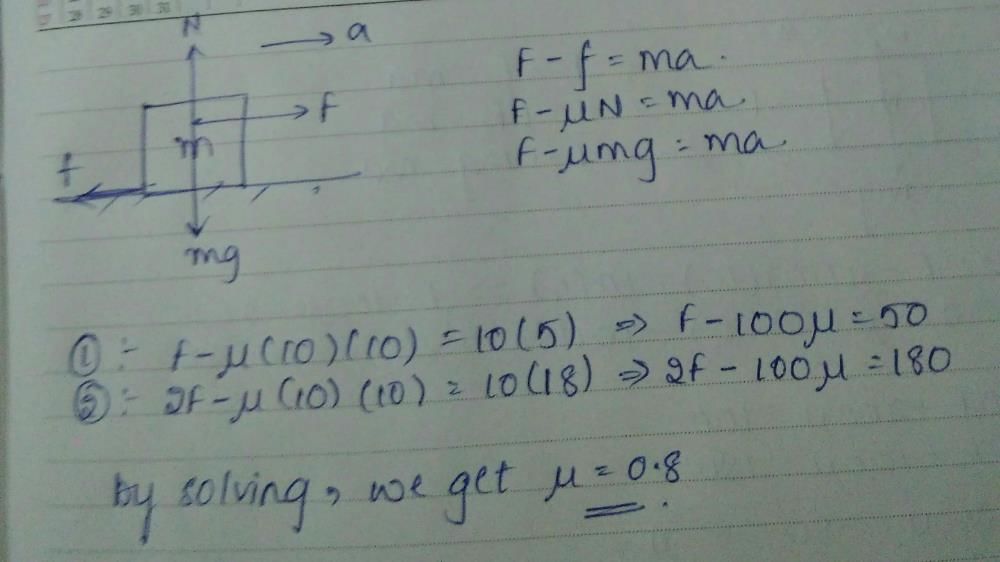
The pair of amphoteric hydroxides is- a)Al(OH)₃, LiOH
- b)B(OH)₃,Be(OH)₂
- c)Be(OH)₂,Mg(OH)₂
- d)Be(OH)₂,Zn(OH)₂
Correct answer is option 'D'. Can you explain this answer?
The pair of amphoteric hydroxides is
a)
Al(OH)₃, LiOH
b)
B(OH)₃,Be(OH)₂
c)
Be(OH)₂,Mg(OH)₂
d)
Be(OH)₂,Zn(OH)₂
|
|
Afifa Aaliya answered |
Beryllium hydroxide and zinc hydroxide are atmospheric in nature because they react with both acid and base.
So option " D " island correct answer.
So option " D " island correct answer.
The ‘Pinch-off’ voltage of a JFET is 4 V. Then the off gate voltage of JFET is- a)4V
- b)2.5 V
- c)2 V
- d)1 V
Correct answer is option 'A'. Can you explain this answer?
The ‘Pinch-off’ voltage of a JFET is 4 V. Then the off gate voltage of JFET is
a)
4V
b)
2.5 V
c)
2 V
d)
1 V

|
Neha Basak answered |
The Cut off gate voltage is also known as pinch off voltage at which the drain current becomes zero.


The reverse leakage current of the transistor when connected in CB Configuration is 0.3 μ A and it is 18 μA when the same transistor is connected in CE Configuration the value of α and β of the transistor for a base current of 40 mA will be respected.- a)0.912 and 79
- b)0.983 and 59
- c)0.887 and 89
- d)0.983 and 89
Correct answer is option 'B'. Can you explain this answer?
The reverse leakage current of the transistor when connected in CB Configuration is 0.3 μ A and it is 18 μA when the same transistor is connected in CE Configuration the value of α and β of the transistor for a base current of 40 mA will be respected.
a)
0.912 and 79
b)
0.983 and 59
c)
0.887 and 89
d)
0.983 and 89

|
Moumita Chopra answered |

Hence α = 0.983 and β = 59
For the amplifier shown below, the drain current changes from 5 mA to 7 mA when the gate voltage D changed from -4.0 V to -3.7 V. The voltage gain of the amplifier is _____
Correct answer is between '-21,19'. Can you explain this answer?
For the amplifier shown below, the drain current changes from 5 mA to 7 mA when the gate voltage D changed from -4.0 V to -3.7 V. The voltage gain of the amplifier is _____

|
Mrinalini Chavan answered |
The gain of the amplifier is given by:
Av = - gmrD
gm: trans conductance of transistor
rD: effective AC resistance seen by drain terminal


gm = 6.66 ms
rD = RD||RL = 6k||6k = 3 kΩ
Av = -6.66 × 10-3 × 3 × 103
Av = -19.98 ≈ 20
The fish Lepidosiren belongs to the country :- a)South Africa
- b)New Zealand
- c)South America
- d)England
Correct answer is option 'C'. Can you explain this answer?
The fish Lepidosiren belongs to the country :
a)
South Africa
b)
New Zealand
c)
South America
d)
England
|
|
Ramesh Chand answered |
Lepidosiren paradoxa is also called the South American lungfish. It is a freshwater and single species of the lungfish found in swamps and slows moving waters of Amazon, Parguay and lower Parona river basins in South America. They burrow into mud during the dry season. Thus, the correct answer is option'C'.
Plants that act as indicators of SO pollution in the atmosphere are- a)Mosses
- b)Liverworts
- c)Orchids
- d)Epiphytic lichens
Correct answer is option 'D'. Can you explain this answer?
Plants that act as indicators of SO pollution in the atmosphere are
a)
Mosses
b)
Liverworts
c)
Orchids
d)
Epiphytic lichens
|
|
Shatabdi Malik answered |
Lichens are the association of algae nd fungi. They are sensitive to SO2 i. e. will not grow in its presence. These are called pollution indicators they don't grow in polluted areas.
In the above monostable multivibrator circuit above given C = 10 nF. If the frequency of output pulse is 100 kHz the resistor value is _________ kΩ
Correct answer is between '0.8,0.94'. Can you explain this answer?
In the above monostable multivibrator circuit above given C = 10 nF. If the frequency of output pulse is 100 kHz the resistor value is _________ kΩ

|
Mrinalini Chavan answered |
The pulse duration in mono-stable multivibrator using 555 timer is T = RC In3
10-5 = 1.1 × R × 10 × 10-9


R = 909.1 Ω
≃ 0.91 kΩ
Which of the following is not readily absorbed in the small intestine?- a)Na+
- b)Cl-
- c)K+
- d)Mg2+
Correct answer is option 'D'. Can you explain this answer?
Which of the following is not readily absorbed in the small intestine?
a)
Na+
b)
Cl-
c)
K+
d)
Mg2+

|
Prince Yasser answered |
Because mg requires specific carrier system to be absorbed by the intestinal cells.about 50% of dietary mg is normally absorbed.
Two RC coupled amplifiers are connected to form a 2-stage amplifier. If the lower and upper cut off frequencies of each individual amplifiers is 100 Hz and 20 kHz. Then the 3-dB bandwidth of the two-state amplifier is ____ Hz.
Correct answer is between '12700,12720'. Can you explain this answer?
Two RC coupled amplifiers are connected to form a 2-stage amplifier. If the lower and upper cut off frequencies of each individual amplifiers is 100 Hz and 20 kHz. Then the 3-dB bandwidth of the two-state amplifier is ____ Hz.

|
Navya Sarkar answered |
Concept:
For multistage amplifier consisting of n identical amplifying states, the lower cut off fL (multi) is expressed as


Where f1 = lower cut off frequency of individual state.
Upper cut off frequency is given by:
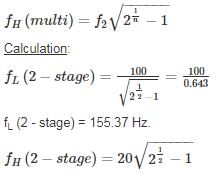

= 20 × 0.643
= 12.87 kHz
Bandwidth =
= 12714.6 Hz.
In IVF technique, fusion of ovum and sperm occurs in:- a)Fallopian tube
- b)Uterus
- c)Vagina
- d)Culture medium
Correct answer is option 'D'. Can you explain this answer?
In IVF technique, fusion of ovum and sperm occurs in:
a)
Fallopian tube
b)
Uterus
c)
Vagina
d)
Culture medium
|
|
Anuradha Thakare answered |
Here IVF stands for in vitro fertilization so it will occur outside the body i.e in culture medium.
A half-wave rectifier is used to charge a 12V battery through a resistance ‘R’. The input transformer is fed with 34 AC with turns ration 2 : 1. The conduction period of the diode is- a)136°
- b)120°
- c)173°
- d)137°
Correct answer is option 'B'. Can you explain this answer?
A half-wave rectifier is used to charge a 12V battery through a resistance ‘R’. The input transformer is fed with 34 AC with turns ration 2 : 1. The conduction period of the diode is
a)
136°
b)
120°
c)
173°
d)
137°

|
Ishita Patel answered |
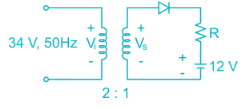
Voltage at secondary winding of the coil is Vs
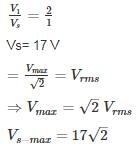
Voltage across diode
Vp → Vs max
Vn → 12 V
For conduction:
Vp > Vn
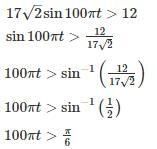
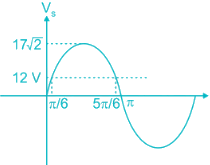
Therefore the diode is conducting for the period.



Therefore the diode is conducting for the period.

The electron of H-atom transits from n = 1 to n = 4 by absorbing energy. If the energy of n = 1 state is – 21.8 × 10-19 Joule then its energy in n = 4 state will be :- a)– 21.8 × 10-19 Joule
- b)– 5.45 × 10-19 Joule
- c)– 2.725 × 10-19 Joule
- d)– 1.362 × 10-19 Joule
Correct answer is option 'D'. Can you explain this answer?
The electron of H-atom transits from n = 1 to n = 4 by absorbing energy. If the energy of n = 1 state is – 21.8 × 10-19 Joule then its energy in n = 4 state will be :
a)
– 21.8 × 10-19 Joule
b)
– 5.45 × 10-19 Joule
c)
– 2.725 × 10-19 Joule
d)
– 1.362 × 10-19 Joule
|
|
Swara Dey answered |
-13.6 eV, then the energy required to excite the electron to n = 4 state can be calculated using the formula:
En = -13.6 eV/n^2
For n = 1, En = -13.6 eV/1^2 = -13.6 eV
For n = 4, En = -13.6 eV/4^2 = -0.85 eV
The energy required to excite the electron from n = 1 to n = 4 is the difference between the energies of these two states:
ΔE = En - E1 = (-0.85 eV) - (-13.6 eV) = 12.75 eV
Therefore, the energy required to excite the electron from n = 1 to n = 4 is 12.75 eV.
En = -13.6 eV/n^2
For n = 1, En = -13.6 eV/1^2 = -13.6 eV
For n = 4, En = -13.6 eV/4^2 = -0.85 eV
The energy required to excite the electron from n = 1 to n = 4 is the difference between the energies of these two states:
ΔE = En - E1 = (-0.85 eV) - (-13.6 eV) = 12.75 eV
Therefore, the energy required to excite the electron from n = 1 to n = 4 is 12.75 eV.
Two waves of same frequency and intensity superimpose with each other in opposite phases, then after superposition the- a)Intensity increarses by 4 times
- b)Intensity increarses by 2 times
- c)Frequency increarses by 4 times
- d)None of these
Correct answer is option 'D'. Can you explain this answer?
Two waves of same frequency and intensity superimpose with each other in opposite phases, then after superposition the
a)
Intensity increarses by 4 times
b)
Intensity increarses by 2 times
c)
Frequency increarses by 4 times
d)
None of these
|
|
Muskaan Maqbool answered |
When two waves of same frequency and intensity with opposite phase superimpose there will b destructive interference and intensity will become zero.
When the gate-to-source voltage VGS of a MOSFET with a threshold voltage of 400mV, working in saturation is 900mV, the drain current is observed to be 1mA. Neglecting the channel width modulation effect and assuming that the MOSFET is operating at saturation, the drain current for an applied VGS of 1400mV is- a)0.5 mA
- b)2.0 mA
- c)3.5 mA
- d)4.0 mA
Correct answer is option 'D'. Can you explain this answer?
When the gate-to-source voltage VGS of a MOSFET with a threshold voltage of 400mV, working in saturation is 900mV, the drain current is observed to be 1mA. Neglecting the channel width modulation effect and assuming that the MOSFET is operating at saturation, the drain current for an applied VGS of 1400mV is
a)
0.5 mA
b)
2.0 mA
c)
3.5 mA
d)
4.0 mA

|
Mahesh Yadav answered |
The MOSFET current is saturation is given by,
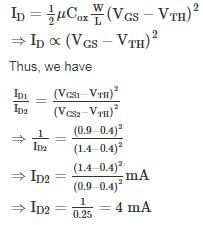

The two stages of the amplifier are shown in the figure. Both transistors have current gain β of 80 and dynamic emitter resistance r′e of 25Ω. The magnitude of the overall voltage gain of the amplifier is approximately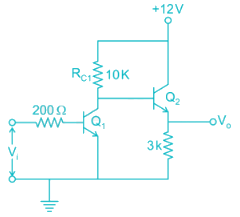
- a)384
- b)515
- c)720
- d)225
Correct answer is option 'A'. Can you explain this answer?
The two stages of the amplifier are shown in the figure. Both transistors have current gain β of 80 and dynamic emitter resistance r′e of 25Ω. The magnitude of the overall voltage gain of the amplifier is approximately

a)
384
b)
515
c)
720
d)
225

|
Ishita Patel answered |
Objective approach
The second stage is emitter follower which has voltage gain of unity.
The overall voltage gain = gain of CE stage

rC1 = effective impedance seen by collector of transistor Q1

Zi(base)Q2 at the base of transistor Q2.
The impedance Zi (base) Q2 at the base of transistor Q2 is
Zi(base)2 = βRE2
= 80 × 3 k

rC1 = effective impedance seen by collector of transistor Q1

Zi(base)Q2 at the base of transistor Q2.
The impedance Zi (base) Q2 at the base of transistor Q2 is
Zi(base)2 = βRE2
= 80 × 3 k
Zi (base) 2 = 240 kΩ
Therefore:

= 10 k||240 k
rC1 = 9.6kΩ

= 10 k||240 k
rC1 = 9.6kΩ
Overall voltage gain

AV− = 3 84

AV− = 3 84
Subjective approach:
Draw the equivalent h-parameter model
rπ = β re = 80 x 25 = 2k
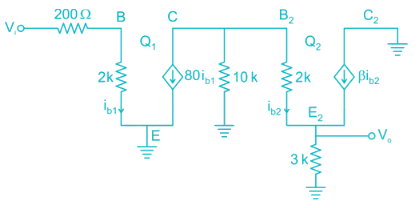

Apply KVL in the base-emitter loop of transistor Q2

Apply KCL at node VB2

800 ib1 = -255 ib2
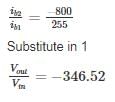


Apply KVL in the base-emitter loop of transistor Q2

Apply KCL at node VB2

800 ib1 = -255 ib2

A: Green muffler are trees planted along the river side.
R: They are able to absorb sound vibration completely. - a)If both Assertion & Reason are true and the Reason is the correct explanation of the Assertion.
- b)If both Assertion & Reason are true but the Reason is not the correct explanation of the Assertion.
- c)If Assertion is true statement but Reason is false.
- d)If Assertion is false statement but Reason is true.
Correct answer is option 'D'. Can you explain this answer?
A: Green muffler are trees planted along the river side.
R: They are able to absorb sound vibration completely.
R: They are able to absorb sound vibration completely.
a)
If both Assertion & Reason are true and the Reason is the correct explanation of the Assertion.
b)
If both Assertion & Reason are true but the Reason is not the correct explanation of the Assertion.
c)
If Assertion is true statement but Reason is false.
d)
If Assertion is false statement but Reason is true.
|
|
Himanshuraj Saini answered |
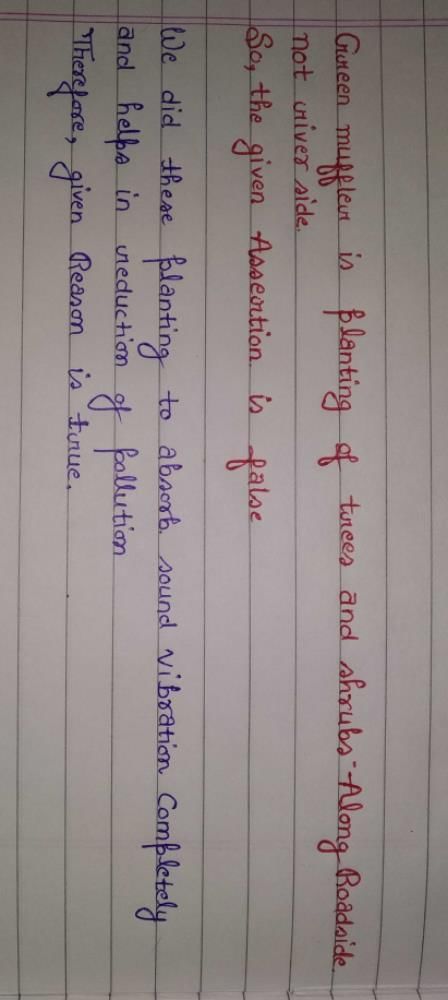
An op-amp has a voltage gain of 100 dB at dc and a unity gain frequency of 5 MHz. The lower 3-dB cut off frequency is _______ Hz.
Correct answer is '50'. Can you explain this answer?
An op-amp has a voltage gain of 100 dB at dc and a unity gain frequency of 5 MHz. The lower 3-dB cut off frequency is _______ Hz.

|
Asha Nambiar answered |
100 dB voltage gain
20 log (Gain) = 100
Gain = 105
GBW = 5 MHz
Low frequency 3-dB = 
= 50 Hz.

= 50 Hz.
Radiations of two photons energies, twice and five times the work function of metal are incident successively on the metal surface. The ratio of the maximum velocity of photoelectrons emitted in the two cases will be- a)1 : 1
- b)1 : 2
- c)1 : 3
- d)1 : 4
Correct answer is option 'B'. Can you explain this answer?
Radiations of two photons energies, twice and five times the work function of metal are incident successively on the metal surface. The ratio of the maximum velocity of photoelectrons emitted in the two cases will be
a)
1 : 1
b)
1 : 2
c)
1 : 3
d)
1 : 4

|
Srishti Sen answered |

Which of the following is not a necessary component in a clamper circuit?- a)Diode
- b)Capacitor
- c)Resistor
- d)Independent DC Supply
Correct answer is option 'D'. Can you explain this answer?
Which of the following is not a necessary component in a clamper circuit?
a)
Diode
b)
Capacitor
c)
Resistor
d)
Independent DC Supply
|
|
Tanya Chauhan answered |
In a clamper circuit, the primary purpose is to shift the DC level of the input signal without altering the shape of the signal. This is achieved by adding a DC bias to the input signal. The necessary components in a clamper circuit include a diode, a capacitor, and a resistor.
- Diode: The diode is an essential component in a clamper circuit as it allows the flow of current in one direction while blocking it in the opposite direction. It helps in shifting the DC level of the input signal by allowing the capacitor to charge or discharge through it.
- Capacitor: The capacitor is another necessary component in a clamper circuit. It is connected in parallel to the diode and is charged or discharged depending on the input signal. The capacitor stores the charge and releases it during the negative half-cycle of the input signal, thereby shifting the DC level of the signal.
- Resistor: The resistor is also an important component in a clamper circuit. It is connected in series with the diode and capacitor. The resistor limits the current flowing through the circuit and helps in stabilizing the voltage across the capacitor.
- Independent DC Supply: The independent DC supply is not a necessary component in a clamper circuit. It is not required because the purpose of a clamper circuit is to shift the DC level of the input signal using the existing components. The diode, capacitor, and resistor work together to achieve this without the need for an additional DC supply.
Therefore, the correct answer is option 'D' - Independent DC Supply.
- Diode: The diode is an essential component in a clamper circuit as it allows the flow of current in one direction while blocking it in the opposite direction. It helps in shifting the DC level of the input signal by allowing the capacitor to charge or discharge through it.
- Capacitor: The capacitor is another necessary component in a clamper circuit. It is connected in parallel to the diode and is charged or discharged depending on the input signal. The capacitor stores the charge and releases it during the negative half-cycle of the input signal, thereby shifting the DC level of the signal.
- Resistor: The resistor is also an important component in a clamper circuit. It is connected in series with the diode and capacitor. The resistor limits the current flowing through the circuit and helps in stabilizing the voltage across the capacitor.
- Independent DC Supply: The independent DC supply is not a necessary component in a clamper circuit. It is not required because the purpose of a clamper circuit is to shift the DC level of the input signal using the existing components. The diode, capacitor, and resistor work together to achieve this without the need for an additional DC supply.
Therefore, the correct answer is option 'D' - Independent DC Supply.
For the given circuit for a 20 Vpeak sinusoidal input vi, what is the value of vi at which the clipping begins?
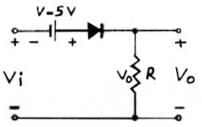
- a)5 V
- b)0 V
- c)-5 V
- d)Clipping doesn’t occur
Correct answer is option 'C'. Can you explain this answer?
For the given circuit for a 20 Vpeak sinusoidal input vi, what is the value of vi at which the clipping begins?


a)
5 V
b)
0 V
c)
-5 V
d)
Clipping doesn’t occur

|
Ankit Mukherjee answered |
It is not possible to determine the value of vi at which the clipping begins without additional information about the circuit. The clipping voltage depends on the specific characteristics and parameters of the circuit, such as the diode threshold voltage or the supply voltage.
Consider series-shunt amplifier in which the open loop gain is Av = 105 and the closed loop gain is AVf = 50. Assume the input and output resistance of the basic amplifier are Ri = 10 kΩ and Ro = 20 kΩ. Determine the input resistance of series input connecting and the output resistance of a shunt output connection for an ideal feedback voltage amplifier.- a)Rin = 20 MΩ and Rout = 20 Ω
- b)Rin = 40 MΩ and Rout = 10 Ω
- c)Rin = 20 MΩ and Rout = 10 Ω
- d)Rin = 30 MΩ and Rout = 200 Ω
Correct answer is option 'C'. Can you explain this answer?
Consider series-shunt amplifier in which the open loop gain is Av = 105 and the closed loop gain is AVf = 50. Assume the input and output resistance of the basic amplifier are Ri = 10 kΩ and Ro = 20 kΩ. Determine the input resistance of series input connecting and the output resistance of a shunt output connection for an ideal feedback voltage amplifier.
a)
Rin = 20 MΩ and Rout = 20 Ω
b)
Rin = 40 MΩ and Rout = 10 Ω
c)
Rin = 20 MΩ and Rout = 10 Ω
d)
Rin = 30 MΩ and Rout = 200 Ω

|
Rahul Sen answered |
The ideal closed-loop voltage transfer function

The input resistance
 The output resistance is
The output resistance is


The input resistance
 The output resistance is
The output resistance is
Mendel’s law of independent assortment always holds good for genes situated on the :- a)Non-homologous chromosomes
- b)Homologous chromosomes
- c)Extra nuclear genetic element
- d)Same chromosome
Correct answer is option 'A'. Can you explain this answer?
Mendel’s law of independent assortment always holds good for genes situated on the :
a)
Non-homologous chromosomes
b)
Homologous chromosomes
c)
Extra nuclear genetic element
d)
Same chromosome
|
|
Aravind Chavan answered |
Non-homologous Chromosome The law of independent assortment holds true as long as two different genes are on separate chromosomes. When the genes are on separate chromosome, the two alleles of one gene (A and a) will segregate into gametes independently of the two alleles of the other gene (B and b). Equal numbers of four different gametes will form AB, aB, Ab, ab. But if the two genes are on the same chromosome, then they will be linked and will segregate together during meiosis, producing only two kinds of gametes.
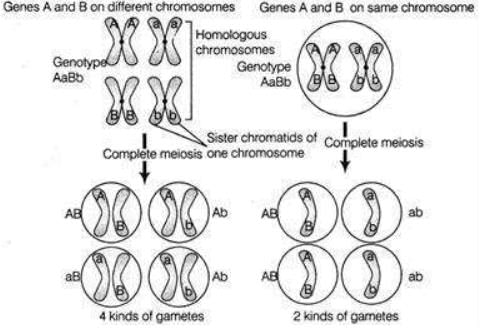
Homologous chromosomes are similar but not identical. Each carries the same gene insame order but the alleles for each trait may not be the same. Extra nuclear genetic elements are also called as plasmids and shows the pattern of maternal inheritance.

Homologous chromosomes are similar but not identical. Each carries the same gene insame order but the alleles for each trait may not be the same. Extra nuclear genetic elements are also called as plasmids and shows the pattern of maternal inheritance.
A dc voltage of 380 V with a peak ripple voltage not exceeding 7 V is required to supply a 500 Ω load. Find out the inductance required.- a)10.8 Henry
- b)30.7 Henry
- c)28.8 Henry
- d)15.4 Henry
Correct answer is option 'C'. Can you explain this answer?
A dc voltage of 380 V with a peak ripple voltage not exceeding 7 V is required to supply a 500 Ω load. Find out the inductance required.
a)
10.8 Henry
b)
30.7 Henry
c)
28.8 Henry
d)
15.4 Henry

|
Moumita Dasgupta answered |
We know that the ripple factor

Where r = RMS value of AC component/DC component
RMS value of AC component = 7/1.414 = 4.95

L = 28.8 H

L = 28.8 H
The equivalent focal length of a Huygen's eye piece- a)3f ∕ 2
- b)3f ∕ 4
- c)2f ∕ 3
- d)4f ∕ 3
Correct answer is option 'A'. Can you explain this answer?
The equivalent focal length of a Huygen's eye piece
a)
3f ∕ 2
b)
3f ∕ 4
c)
2f ∕ 3
d)
4f ∕ 3
|
|
Sai Nikhil answered |
The equivalent focal length of huygens eye piece is 3f/2 the distance between eye piece and object pieces is 2f and focal lengths are in the ratio 1:3 so, the we get 3f/2
A class – A transformer coupled, the Transistor power amplifier is Required to deliver a power output of 10 watts, the maximum power rutting of the transistor should not be less than –
Correct answer is between '19,20'. Can you explain this answer?
A class – A transformer coupled, the Transistor power amplifier is Required to deliver a power output of 10 watts, the maximum power rutting of the transistor should not be less than –

|
Arjun Unni answered |
PiDC = Poac + PTr
Pooc = 10 W
η = 50% for class-A transformer coupled


The efficiency of a class B amplifier with a supply voltage of 24V and peak output voltage Vo = 22V is _______%
Correct answer is between '71,73'. Can you explain this answer?
The efficiency of a class B amplifier with a supply voltage of 24V and peak output voltage Vo = 22V is _______%

|
Bijoy Mehra answered |
For a class B amplifier with VCC = 24 V and VO = 22 V efficiency η (in %) is given by


Assuming the diode to be ideal, the current I in the circuit shown is ________ mA.
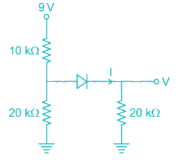
Correct answer is between '0.2,0.25'. Can you explain this answer?
Assuming the diode to be ideal, the current I in the circuit shown is ________ mA.



|
Sonal Tiwari answered |
The above circuit can be redrawn as:


Assume diode is off:
Voltage across 20 k resistor connected to left of diode is


This will turn on the diode
the equivalent circuit is now:
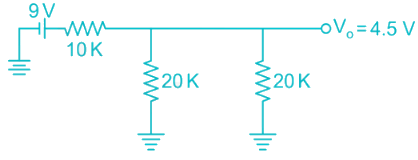

Now the two 20k resistors are in parallel whose equivalent is 10k
this 10 k is in series with other 10k resistor
9V divides equally among them
V0 = 4.5V
Cuurent I = 4.5/20 mA
= 0.225 mA
A concave lens of focal length 20cm forms the image of an object which is placed at infinity. The size of image formed is 1cm. If a convex lens of focal length 10cm is placed 10cm from the concave lens. Find the new image size ?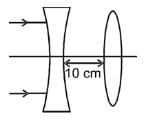
- a)1.5 cm
- b)0.5 cm
- c)2 cm
- d)1.2 cm
Correct answer is option 'B'. Can you explain this answer?
A concave lens of focal length 20cm forms the image of an object which is placed at infinity. The size of image formed is 1cm. If a convex lens of focal length 10cm is placed 10cm from the concave lens. Find the new image size ?

a)
1.5 cm
b)
0.5 cm
c)
2 cm
d)
1.2 cm

|
Meghana Devi answered |
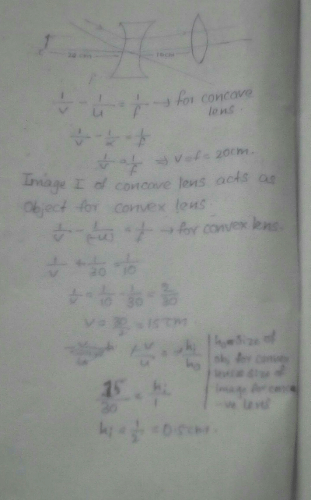
A MOSFET operating in saturation mode is shown in the below figure. The drain current is given as ID = ½ (VGS – 0.75)2 mA If VS = 5V, then the value of RS in kΩ is __________
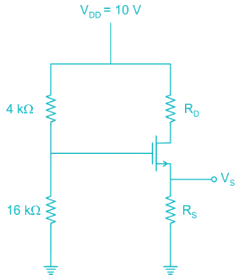
Correct answer is between '1.9,2'. Can you explain this answer?
A MOSFET operating in saturation mode is shown in the below figure. The drain current is given as ID = ½ (VGS – 0.75)2 mA If VS = 5V, then the value of RS in kΩ is __________



|
Nilanjan Rane answered |
The bias used in the given circuit is voltage divider bias. The gate voltage 

∴ Gate source voltage VGS = VG - VS
= 8 – 5
= 3 V
∴ ID = ½ (3 - 0.75)2 mA
≅ 2.53 mA
VS = RSID


Little leaf disease of Brinjal is caused by an- a)Algae
- b)Fungus
- c)Mycoplasma
- d)Bacterium
Correct answer is option 'C'. Can you explain this answer?
Little leaf disease of Brinjal is caused by an
a)
Algae
b)
Fungus
c)
Mycoplasma
d)
Bacterium
|
|
Mahak Agrawal answered |
Little leaf, or witches' broom, is a disease of sweetpotato caused by a mycoplasma-like organism. Affected plants have small, thickened and sometimes chlorotic young leaves which may be mistaken for zinc deficiency.
In the circuit shown below the parameters are gm = 
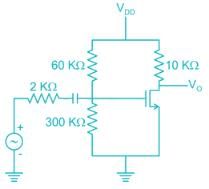
Correct answer is between '-8.5,7.5'. Can you explain this answer?
In the circuit shown below the parameters are gm = 




|
Pankaj Rane answered |
The small signal equivalent circuit is as shown below
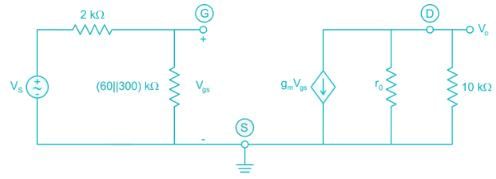
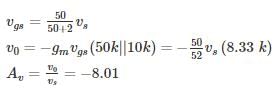


The frequency of oscillation of the circuit shown below is ________ Hz.
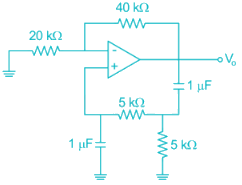
Correct answer is between '30,32'. Can you explain this answer?
The frequency of oscillation of the circuit shown below is ________ Hz.



|
Sandeep Sen answered |
The given oscillator is Wien-bridge oscillator with R = 5 kΩ, C = 1 μF
⇒ frequency of oscillation f = 1/2πRC


= 31.8 Hz
Chapter doubts & questions for Practice Tests - 6 Months Preparation for GATE Electrical 2025 is part of Electrical Engineering (EE) exam preparation. The chapters have been prepared according to the Electrical Engineering (EE) exam syllabus. The Chapter doubts & questions, notes, tests & MCQs are made for Electrical Engineering (EE) 2025 Exam. Find important definitions, questions, notes, meanings, examples, exercises, MCQs and online tests here.
Chapter doubts & questions of Practice Tests - 6 Months Preparation for GATE Electrical in English & Hindi are available as part of Electrical Engineering (EE) exam.
Download more important topics, notes, lectures and mock test series for Electrical Engineering (EE) Exam by signing up for free.
6 Months Preparation for GATE Electrical
675 videos|1297 docs|786 tests
|

Contact Support
Our team is online on weekdays between 10 AM - 7 PM
Typical reply within 3 hours
|
Free Exam Preparation
at your Fingertips!
Access Free Study Material - Test Series, Structured Courses, Free Videos & Study Notes and Prepare for Your Exam With Ease

 Join the 10M+ students on EduRev
Join the 10M+ students on EduRev
|

|
Create your account for free
OR
Forgot Password
OR
Signup on EduRev and stay on top of your study goals
10M+ students crushing their study goals daily


